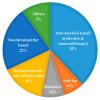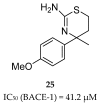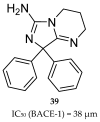BACE-1 and γ-Secretase as Therapeutic Targets for Alzheimer's Disease
- PMID: 30893882
- PMCID: PMC6469197
- DOI: 10.3390/ph12010041
BACE-1 and γ-Secretase as Therapeutic Targets for Alzheimer's Disease
Abstract
Alzheimer's disease (AD) is a growing global health concern with a massive impact on affected individuals and society. Despite the considerable advances achieved in the understanding of AD pathogenesis, researchers have not been successful in fully identifying the mechanisms involved in disease progression. The amyloid hypothesis, currently the prevalent theory for AD, defends the deposition of β-amyloid protein (Aβ) aggregates as the trigger of a series of events leading to neuronal dysfunction and dementia. Hence, several research and development (R&D) programs have been led by the pharmaceutical industry in an effort to discover effective and safety anti-amyloid agents as disease modifying agents for AD. Among 19 drug candidates identified in the AD pipeline, nine have their mechanism of action centered in the activity of β or γ-secretase proteases, covering almost 50% of the identified agents. These drug candidates must fulfill the general rigid prerequisites for a drug aimed for central nervous system (CNS) penetration and selectivity toward different aspartyl proteases. This review presents the classes of γ-secretase and beta-site APP cleaving enzyme 1 (BACE-1) inhibitors under development, highlighting their structure-activity relationship, among other physical-chemistry aspects important for the successful development of new anti-AD pharmacological agents.
Keywords: Alzheimer’s disease; BACE-1; amyloid hypothesis; γ-secretase.
Conflict of interest statement
The authors declare no conflict of interest.
Figures





































Similar articles
-
BACE knockout mice are healthy despite lacking the primary beta-secretase activity in brain: implications for Alzheimer's disease therapeutics.Hum Mol Genet. 2001 Jun 1;10(12):1317-24. doi: 10.1093/hmg/10.12.1317. Hum Mol Genet. 2001. PMID: 11406613
-
Beta-secretase protein and activity are increased in the neocortex in Alzheimer disease.Arch Neurol. 2002 Sep;59(9):1381-9. doi: 10.1001/archneur.59.9.1381. Arch Neurol. 2002. PMID: 12223024
-
Amyloid precursor protein compartmentalization restricts beta-amyloid production: therapeutic targets based on BACE compartmentalization.J Mol Neurosci. 2004;24(1):137-43. doi: 10.1385/JMN:24:1:137. J Mol Neurosci. 2004. PMID: 15314262
-
Beta-secretase (BACE) as a drug target for Alzheimer's disease.Adv Drug Deliv Rev. 2002 Dec 7;54(12):1589-602. doi: 10.1016/s0169-409x(02)00157-6. Adv Drug Deliv Rev. 2002. PMID: 12453676 Review.
-
The beta-secretase, BACE: a prime drug target for Alzheimer's disease.J Mol Neurosci. 2001 Oct;17(2):157-70. doi: 10.1385/JMN:17:2:157. J Mol Neurosci. 2001. PMID: 11816789 Review.
Cited by
-
Differentially expressed long noncoding RNAs and mRNAs in PC12 cells under lysophosphatidylcholine stimulation.Sci Rep. 2022 Nov 11;12(1):19333. doi: 10.1038/s41598-022-21676-5. Sci Rep. 2022. PMID: 36369435 Free PMC article.
-
Capturing Amyloid-β Oligomers by Stirring with Microscaled Iron Oxide Stir Bars into Magnetic Plaques to Reduce Cytotoxicity toward Neuronal Cells.Nanomaterials (Basel). 2020 Jun 30;10(7):1284. doi: 10.3390/nano10071284. Nanomaterials (Basel). 2020. PMID: 32629933 Free PMC article.
-
Jagged1 intracellular domain/SMAD3 complex transcriptionally regulates TWIST1 to drive glioma invasion.Cell Death Dis. 2023 Dec 13;14(12):822. doi: 10.1038/s41419-023-06356-0. Cell Death Dis. 2023. PMID: 38092725 Free PMC article.
-
Prospective Application of Activity-Based Proteomic Profiling in Vision Research-Potential Unique Insights into Ocular Protease Biology and Pathology.Int J Mol Sci. 2019 Aug 8;20(16):3855. doi: 10.3390/ijms20163855. Int J Mol Sci. 2019. PMID: 31398819 Free PMC article. Review.
-
Allostery Inhibition of BACE1 by Psychotic and Meroterpenoid Drugs in Alzheimer's Disease Therapy.Molecules. 2022 Jul 8;27(14):4372. doi: 10.3390/molecules27144372. Molecules. 2022. PMID: 35889246 Free PMC article.
References
-
- Duthey B. Background Paper 6.11 Alzheimer Disease and Other Dementias, Update on 2004. World Health Organization; Geneva, Switzerland: Feb, 2013. pp. 1–77.
-
- Eurostat Population Structure and Ageing. [(accessed on 5 January 2019)]; Available online: http://ec.europa.eu/eurostat/statistics-explained/index.php/Population_s....
-
- Alzheimer’s Association 2017 Alzheimer’s disease facts and figures. Alzheimer’s Dement. 2017;13:325–373.
Publication types
Grants and funding
LinkOut - more resources
Full Text Sources

